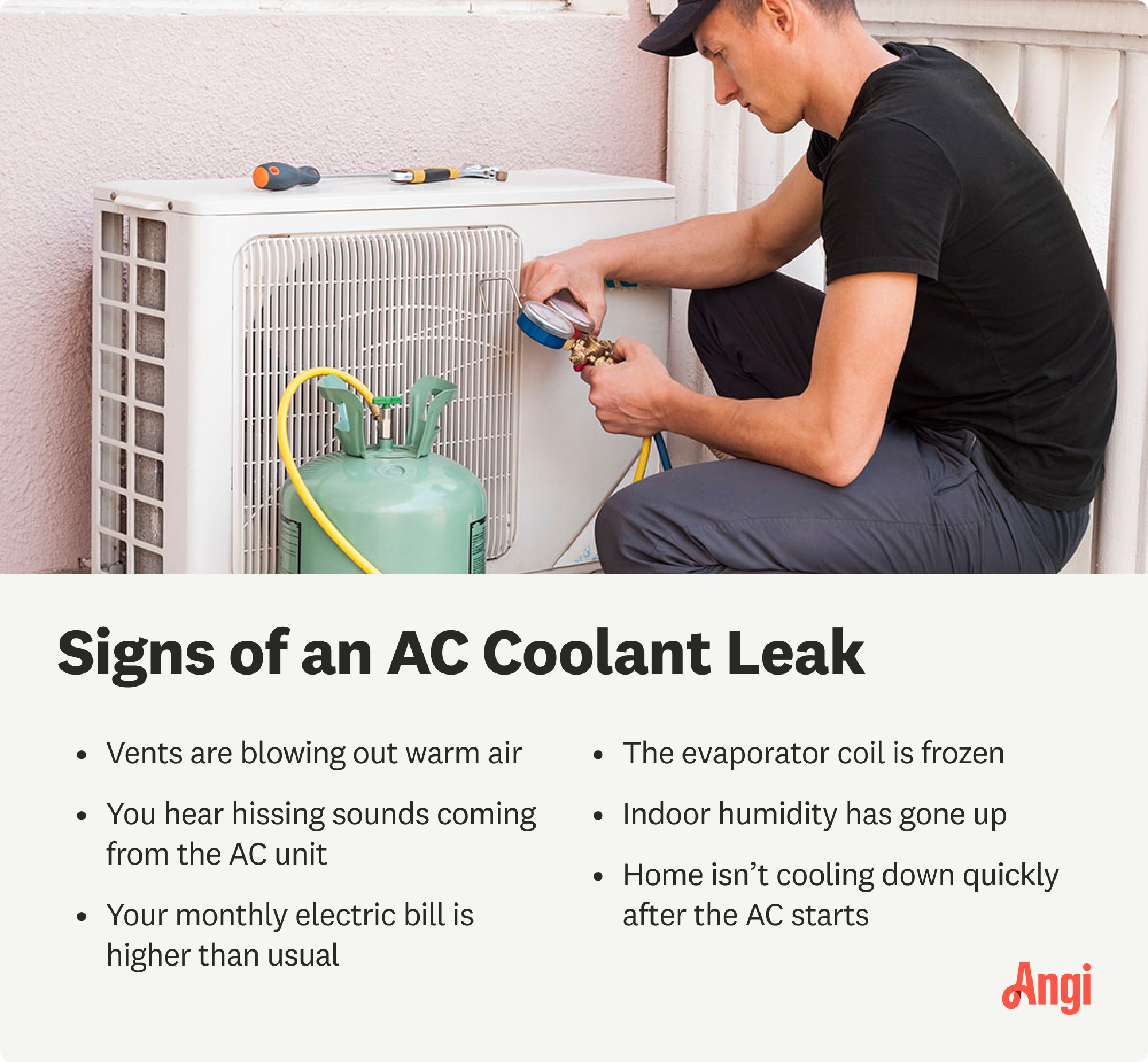How Much Does a Coolant Leak Repair Cost on Your Air Conditioner? [2025 Data]
Coolant leak repair costs $1,075 on average, but costs often range from $225 and $2,000 depending on the detection system used and the repair needed. Call a pro for an estimate on repairs for your specific system.


A coolant leak repair costs $1,075 on average, but the total can be as low as $150 or as high as $3,000. Air conditioning coolants used in your home's HVAC system help to cool down the air temperature. While you may not be able to diagnose a leak on your own, your home suddenly taking longer to cool down to a comfortable temperature is a telltale sign. You may also notice hissing sounds, visible leaking, or a mysteriously high energy bill. This guide will show you what to expect for specific repairs.
HVACs are one of the most complicated and essential systems in our homes. To avoid further damage or safety risks, always hire a certified HVAC specialist to repair or replace broken parts.
Coolant Leak Cost Factors
A local HVAC pro may need to spend some time diagnosing the cause of your AC coolant leak. Common leak causes include factory defects, thinned-out connectors and joints, corrosion of copper tubing, incorrect installation, and worn rubber seals. A pro's findings will help to determine costs for parts and labor.
Service Call Fees
Most air conditioning pros charge $75 to $120 for service calls for detecting refrigerant leaks. A service call simply covers the cost to have a professional come out to inspect the issue. Most companies will fold the cost of the service call into your total fee if you decide to accept an estimate.
Labor
Most air conditioning repair technicians charge between $75 and $150 per hour. A professional should always inform you of their hourly fee before beginning any work during a service call. If you're placing an after-hours call because you need an urgent repair, you may be charged an emergency rate that's closer to $250.
Leak Detection and Testing
In most cases, an air conditioning repair expert will need to conduct testing to determine the source of a leak. Testing options range from rudimentary to highly sophisticated. Here's what you can expect to pay for various leak-detection tests:
| Type of Test | Cost | Test Details |
|---|---|---|
| Bubble test | $15–$25 | Pro dabs soap and water over areas to check for air bubbles |
| Dye detection | $35–$275 | Pro injects fluorescent dye in HVAC system, looks for UV light in leaking spot |
| Torch detection | $150–$400 | A color-changing flame turns green when it detects a coolant leak |
| Nitrogen detection | $300–$500 | Pro adds refrigerant and compressed nitrogen product to HVAC, which creates sound in leaking section |
| Ultrasonic detection | $100–$1,100 | Pro uses a device to listen for the leak |
| Electronic detection | $150–$1,200 | Pro uses a device with sensors to alert to leak location |
Repair Type
After diagnosing your leak, your AC tech will recommend a repair solution. Repair costs can vary based on the age of your system, the seriousness of the damage, and the accessibility of your HVAC components. In addition, you will be charged for any replacement parts that are needed. Here's a look at average costs for common AC coolant leak fixes:
| Part Repair | Repair Cost | Role |
|---|---|---|
| Evaporator coil | $350–$1,000 | Cools the air using refrigerant |
| Condenser coil | $850–$1,100 | Releases warm air by condensing the refrigerant |
| Compressor | $700–$1,200 | Compresses refrigerant and pushes it through the system |
| Refrigerant/freon | $100–$600 | Refrigerant absorbs heat from passing air |
A technician may also charge you for time spent recharging your air conditioning unit after a leak has been repaired. Prior to approving an estimate, you should search your records for all warranty and manufacturer information for your unit. It's possible that parts that are in need of repair or replacement may still be under warranty.
Replacement
If it's determined that your unit cannot be saved, your technician may let you know that you need a full replacement. This can cost anywhere from $500 to $17,000. However, most homeowners can expect a full AC unit replacement to cost around $6,000.
Additional Costs to Consider

The coolant leak repair cost for your project may not stop at simple parts and labor. In cases where your technician needs to do some deconstruction in order to access your leak source, you may need to budget for some extra costs. Additionally, you may need to cover some repair costs if the coolant leak damages any part of your home.
Here are some additional costs to include in your coolant leak repair budget:
Coolant recharging: AC technicians charge $100–$500 to refill coolant after they repair the leak.
Cleaning: If the coolant left a mess behind, expect to spend $4–$5 per square foot for cleanup by a certified AC technician. Never attempt to clean coolant on your own.
Flooring repair or replacement: Repairing floors affected by the leak will cost $2–$25 per square foot, depending on the flooring type and extent of the damage.
Drywall repair: If the leak impacted walls near the AC unit, you’ll pay $0.50–$0.75 per square foot for drywall repair, plus $0.75 to $2 per square foot for old drywall disposal.
Cost to Repair an AC Coolant Leak Yourself
It's important to be realistic about the fact that a coolant leak is a serious issue that can potentially be dangerous for your household. You should never attempt dangerous DIY repairs involving Freon™ or electricity. This is why it's highly recommended that homeowners call HVAC professionals to assess leaks before attempting to handle the problem alone.
Coolant leak detection tools can be purchased for between $50 and $100. However, it's important to note that these are not the same high-level tools that professionals use when they show up to your home to detect coolant leaks. The cost for a new compressor is between $500 and $900. Evaporator and condenser coils can cost from $200 to $900.
DIY vs. Hiring a Pro
While the average coolant leak repair cost when hiring a pro specializing in local air conditioning repair is between $150 and $2,000 with everything from the service call to parts and labor included, homeowners attempting to fix a coolant leak on their own can pay around $800 to correct common issues. Of course, there's no guarantee that someone without experience with HVAC systems will diagnose and fix the problem correctly. Unfortunately, this could lead to even bigger issues that will cost more in the long run. An improperly repaired air conditioner can also pose health and safety hazards in a home.
Cost of Common Coolant Leak Repair Add-Ons
After fixing your leak, your air conditioning technician may alert you to the fact the problem was caused by improper unit care. If you're alarmed by how easily a coolant leak can slip under the radar, you may be feeling motivated to start putting some routine AC maintenance on the calendar. Here's a look at some common services to schedule while you're in contact with a repair expert:
Routine AC unit inspections: $190–$400
Routine tuneup appointments: $75–$20
Filter replacements: $20–$50
Sealant application: $30–$50
Ways You Can Save Money on Coolant Leak Repair Costs
While there aren't many ways to cut corners with coolant leak repair costs, homeowners can reduce project costs with these helpful tips.
Prepare the space: Prior to the arrival of your air conditioning tech, clear the area to provide an open workspace. Some companies charge prep costs if they need to clear areas before they can access them.
DIY easy tasks: If damage needs to be repaired following a leak repair, you can remove damaged drywall, rip up old carpets, or refinish wood floors on your own to cut down on costs.
Check for mold: If you know how to check for mold, you could save on the costs for mold inspection. However, you will probably need to pay for professional mold remediation if your AC unit has caused any kind of water damage.
Check your warranty: Some parts on a newer unit may be covered under your warranty. Always refer to the manufacturer and installation documents that came with your air conditioner or HVAC unit so see if the work being done could be under warranty. This step could save you thousands of dollars.
How Angi Gets Its Cost Data
Home is the most important place on earth, which is why Angi has helped more than 150 million homeowners transform their houses into homes they adore. To help homeowners with their next project, Angi provides readers with the most accurate cost data and upholds strict editorial standards. We extensively research project costs to develop the pricing data you see, so you can make the best decisions for you and your home. We rely on reputable sources, including the U.S. Bureau of Labor Statistics, academic journals, market studies, and interviews with industry experts—all to ensure our prices reflect real-world projects.
Want to help us improve our cost data? Send us a recent project quote to costquotes@angi.com. Quotes and personal information will not be shared publicly.
Frequently Asked Questions
One of the reasons why homeowners shouldn't attempt DIY coolant leak repairs is that handling coolants and refrigerants can be dangerous. It's recommended that you hire a NATE-certified, EPA-certified, and ACCA-accredited professional to handle this important repair!
While it's generally safe to stay in a home with a coolant leak if your home is properly ventilated, it's important to have a professional come out to assess the situation right away. You should evacuate your home if you notice any powerful fumes. Additionally, you should leave your home if you are experiencing headaches or dizziness.
Yes, it's normal for air conditioners to leak tiny amounts of water due to condensation. Under normal circumstances, all excess moisture travels to the drain pan to be pumped through your system's drain line. You should call a technician to diagnose the issue if you're noticing frequent leaking or pooling. It's also important to investigate if your homeowners insurance can cover water damage.
It can be difficult to determine the cause of a coolant leak unless you have the unit inspected by a certified professional. Most coolant leaks are caused by wear and tear on seals and joints. This typically happens five years after a unit is installed. Additionally, faulty or worn compressors, evaporator coils, and condenser coils can also cause leaks.





- Furnace Repair
- Air Conditioning Repair
- HVAC Repairs
- Furnace Installation
- Wood & Pellet Stove Repair
- Dehumidifier & Humidifier Repair
- Heat Pump Companies
- Swamp Cooler Repair
- Wood Stove Services
- HVAC Companies
- Commercial A/C Repair
- Geothermal Installation
- Air Conditioning Installation
- Boiler Repair
- 24 Hour Furnace Repair
- Geothermal Repair
- Heat Pump Repair
- Humidifier Installation
- Thermostat Repair
- Thermostat Installation
- Nest Installation
- Heating & Cooling
- Heating Repair
- Furnace Cleaning
- Furnace Tune-Up
- HVAC Technicians
- Subcontractors
- Furnace Maintenance
- Plumbing & Heating Companies
- Wood Stove Inspection
- Mini Split Installation
- Wall Heater Repair
- Duct Installers












